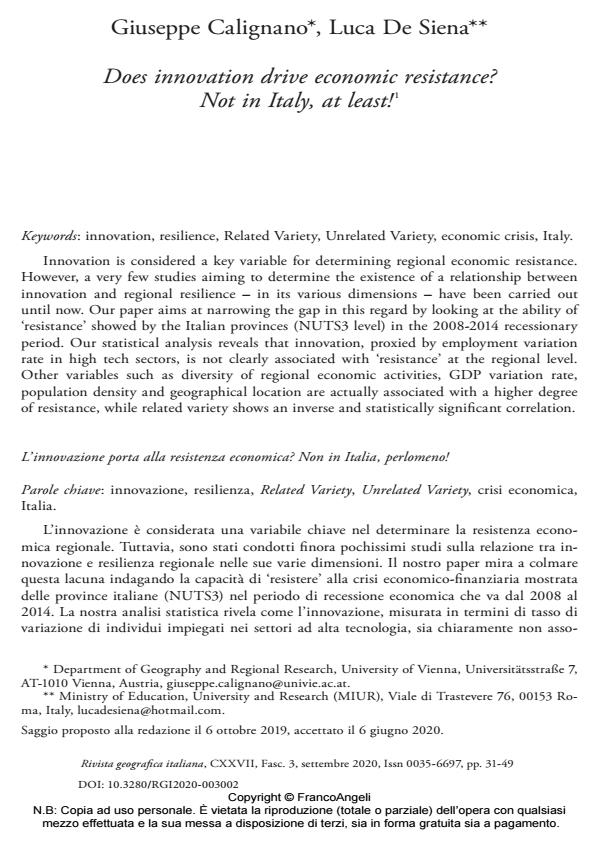Does innovation drive economic resistance? Not in Italy, at least!
Journal title RIVISTA GEOGRAFICA ITALIANA
Author/s Giuseppe Calignano, Luca De Siena
Publishing Year 2020 Issue 2020/3
Language English Pages 19 P. 31-49 File size 163 KB
DOI 10.3280/RGI2020-003002
DOI is like a bar code for intellectual property: to have more infomation
click here
Below, you can see the article first page
If you want to buy this article in PDF format, you can do it, following the instructions to buy download credits

FrancoAngeli is member of Publishers International Linking Association, Inc (PILA), a not-for-profit association which run the CrossRef service enabling links to and from online scholarly content.
Innovation is considered a key variable for determining regional economic resistance. However, a very few studies aiming to determine the existence of a relationship between innovation and regional resilience - in its various dimensions - have been carried out until now. Our paper aims at narrowing the gap in this regard by looking at the ability of ‘resistance’ showed by the Italian provinces (NUTS3 level) in the 2008-2014 recessionary period. Our statistical analysis reveals that innovation, proxied by employment variation rate in high tech sectors, is not clearly associated with ‘resistance’ at the regional level. Other variables such as diversity of regional economic activities, GDP variation rate, population density and geographical location are actually associated with a higher degree of resistance, while related variety shows an inverse and statistically significant correlation.
Keywords: Innovation, resilience, Related Variety, Unrelated Variety, economic crisis, Italy
- From Adversity to Advantage: A Systematic Literature Review on Regional Economic Resilience Mantas Rimidis, Mindaugas Butkus, in Urban Science /2025 pp.118
DOI: 10.3390/urbansci9040118 - Knowledge and innovation dynamics of the Northwest Russia under geopolitical changes A. S. Mikhaylov, D. D. Maksimenko , M. R. Maksimenko , M. M. Filatov , in Baltic Region /2023 pp.79
DOI: 10.5922/2079-8555-2023-4-5 - A inovação pode prever a resiliência regional? Uma exploração econométrica dos municípios brasileiros durante a pandemia de COVID-19 Luiz Fernando Câmara Viana, Valmir Emil Hoffmann, Hugo Pinto, in International Journal of Innovation e24738/2024 pp.1
DOI: 10.5585/2024.24738
Giuseppe Calignano, Luca De Siena, Does innovation drive economic resistance? Not in Italy, at least! in "RIVISTA GEOGRAFICA ITALIANA" 3/2020, pp 31-49, DOI: 10.3280/RGI2020-003002